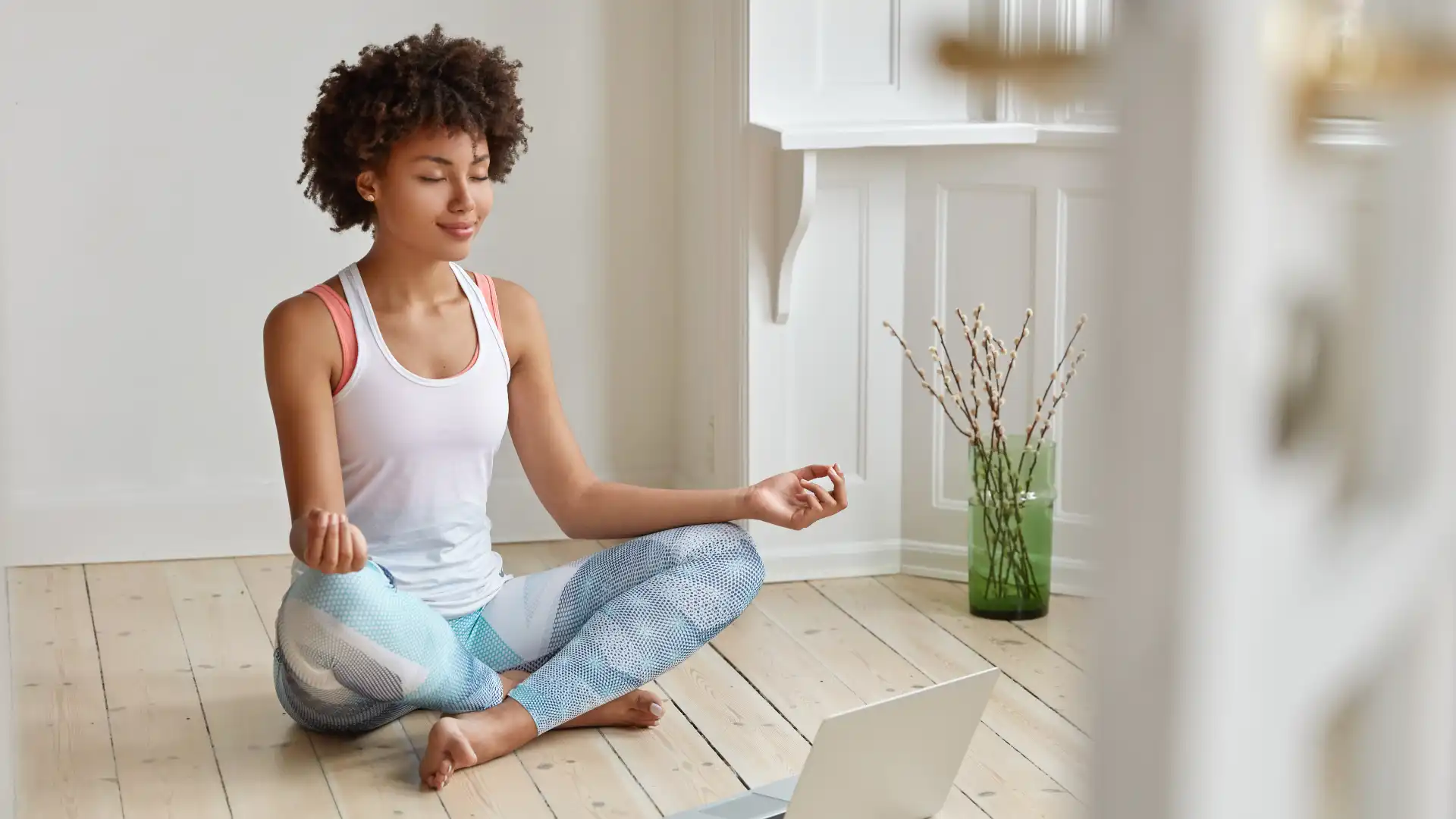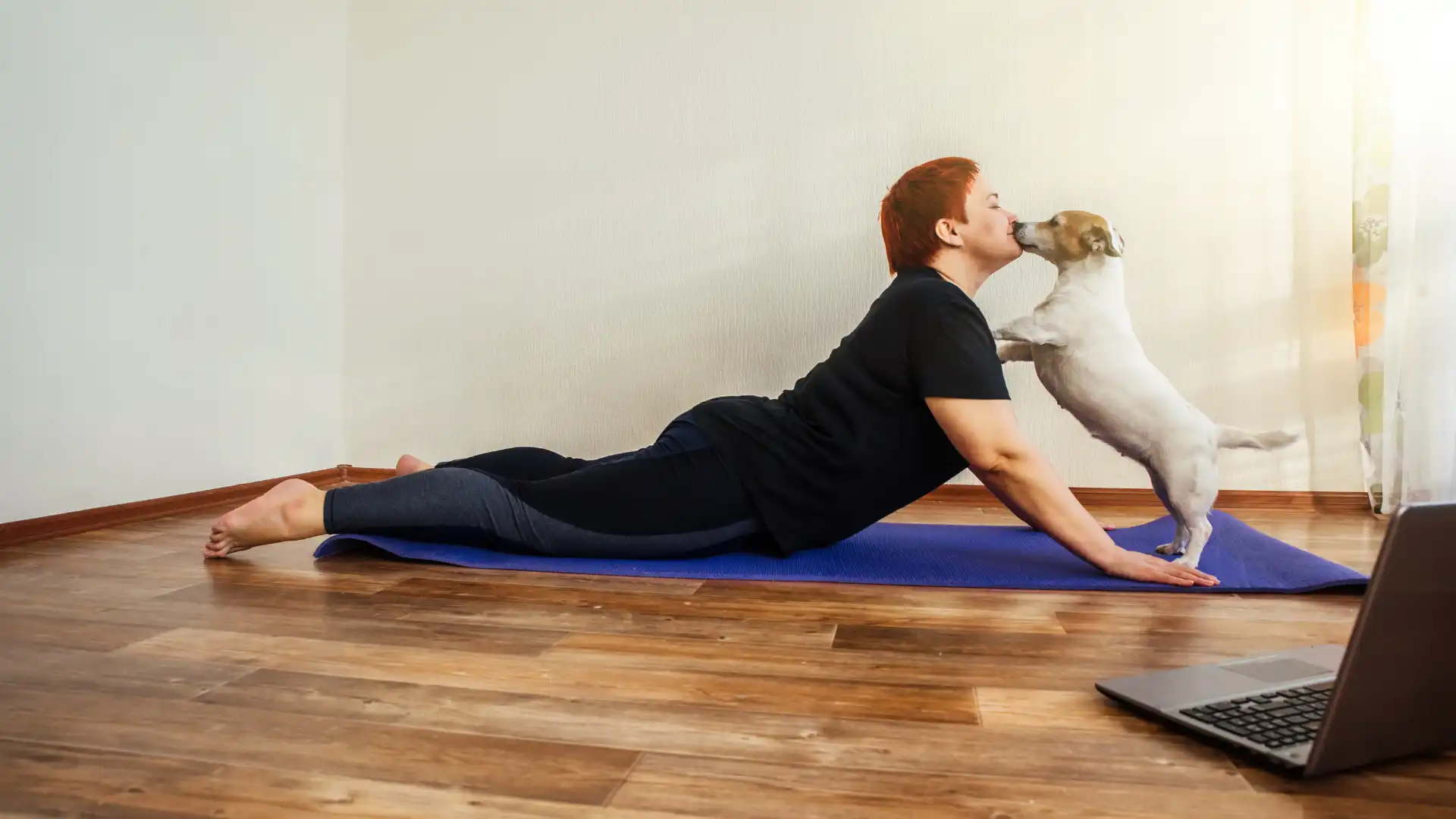Optimize Your Zoom Yoga Classes

Six months ago, who would have thought we’d find ourselves quarantined? The times are challenging us all, one way or another. My yoga studio has been closed since mid-March and will be closed at least until the end of April 2020. Who knows after that?
As a confirmed tech luddite, I wasn’t at all sure about offering online yoga classes. But when several students asked me if I’d be offering Zoom classes, I decided to look into it. As with everything, there are upsides and downsides to teaching remotely. But overall, online classes have provided a great opportunity to stay in touch with my yoga community, even if we can’t share the same physical space.
In this post, I’ll share my experiences so far—the positive and the challenging—along with a few ways I’ve discovered to optimize the experience for my students. Since most readers are likely more tech-savvy than I am, I won’t go into Zoom features. Instead, I’ll stick with what I’m learning about making the experience as comfortable and helpful as possible.

The Advantages of Zoom Yoga Classes
- Consistency: Yoga practice benefits from consistency. When you set aside a time to practice each week, practice more easily becomes a habit. Once regular practice becomes a habit, it’s easier to stay consistent. Offering online classes at your regular teaching times helps your students continue with their practice.
- Normalcy: At a time when our normal lives have been upended, offering yoga classes at the usual days and times can provide grounding for you and your students.
- Community: While it’s not the same as sharing physical space, I’ve found that the periods before and after my Zoom classes give students a chance to connect in a semi-normal way.
- Accessibility: Some of my students travel 10 to 20 miles to come to classes. Practicing at home eliminates travel time and traffic stress. I’ve also invited my sisters and a few friends from elsewhere in the country to my online classes. Former students who moved out of state have been attending. It’s been lovely to reconnect with them.
- Happiness for Homebodies: Some students have told me that they like practicing by themselves in the comfort of their own homes. While I strive to make my classes a non-competitive experience, many people still feel pressure to “perform” when they’re in a group. Zoom classes eliminate this pressure.
- Yoga in Your PJs: My classes are not known for their adherence to high yoga fashion. But it’s a fact that going out and being among people makes you think a bit more about what you’re wearing. Students in my early morning classes have told me that they enjoy practicing in their PJs.
- Animal Companions: My cats regularly attend my Zoom classes, and I often see other people’s four-legged friends walking past their screens. It’s fun for people to introduce fellow students to their animal friends. Of course, this could be a challenge as well, if your best friends are getting in the way of your practice. If that is the case, find a space where you can close them out, at least for a little while.

The Challenges of Zoom Yoga Classes
- Teaching to a Screen: Before the pandemic, I had taught meditation on Zoom a few times. So I was already familiar with the strangeness of teaching to a computer screen. Teaching yoga is even stranger since I have to position myself further away from the screen. When I’m demonstrating standing poses, I have to be quite far from the computer. In order for students to hear me, I need to project my voice and make sure that I enunciate very clearly. As time passes, I’m getting used to it.
- Not Seeing Students: This may be the biggest challenge. When you can’t see what students are doing, you can’t help them adjust their poses to avoid misalignment or injury. It’s easy for me to scan a real-life room to see how students are practicing. In online classes, you can’t effectively scan the room. In this case, demonstrating the poses, practicing along with students, will probably be the most helpful.
- Lack of Props: You don’t know what props students have in their homes. While most of my students own yoga mats, blocks, bolsters, straps and blankets, some of my students don’t. My studio has a well-stocked prop room, so I can say, “Go get two blocks and a bolster,” etc., whenever I need to. In online classes, I can’t offer some of the prop-intensive poses my students really like. So take a lack of yoga props into consideration as you plan your classes.
- Community Disconnect: Most of my students have been coming to class for a long time. Students often share life experiences and their own special knowledge before and after my classes. Sometimes students will stay as long as 15 minutes or more sharing their thoughts about gardening, cats and dogs, health info, etc. While we get to check-in and say hello on Zoom, it’s not the same as the spontaneous discussions we enjoy in person. Perhaps another component of Zoom yoga could be to schedule informal meetings—no yoga, just talking and catching up.

How to Optimize your Zoom Yoga Classes
- Set Up Your Space: Find a space in your home where you can set your computer far enough away that your whole body is in view. Have the props you want to use close by.
- Check Your Sound: Before you start, do a test run with a friend to make sure that you’re audible. The computer mic has worked fine for my classes, but some people use a Lavalier Mic or AirPods to make the sound clearer. I tried Airpods and they fell out of my ears when I practiced poses. A Lavalier Mic might work better, but there can still be problems with the volume and clarity when you’re moving around. Ask for feedback from your students as to what works for them. If you’re using your computer mic, move closer to the computer when you’re practicing poses on the floor. That way, you won’t need to talk as loudly in order to be heard.
- Plan Ahead and Communicate: Plan classes around props that students might have on hand and let your students know your plans. In a studio, props are all accessible in one place. You can’t count on that when people are practicing at home. On Sundays, I send out an email that lists the focus for each class (standing poses, hips, shoulders, etc.) in the coming week, along with what props they’ll need, including improvised props such as throw pillows. That way, students can have their own spaces set up at the start of class.
- Use the Mute Button: It’s a good idea to mute students once you start teaching the class. If you don’t, background noise can be distracting to you and your students. If students want to ask a question, they can always unmute themselves while they’re talking. Just make sure they hit the mute button after they’re finished—or you can do it for them.
- Keep It Simple: Because you can’t see students, teach simple, staple poses. Teach poses that you know will be easily accessible to all your students. Make sure to suggest and demonstrate modifications, as you would in a live class.
- Stick to Your Regulars: Now is probably not the time to invite new students to your established classes. Since it’s not so easy to see people’s alignment, inviting unfamiliar students to your classes could possibly cause confusion or even injury. Better to stick with students who are familiar with the poses and your style of teaching.
Yoga practice provides ballast in times when the world feels unsteady. I’m grateful to live in a time when online classes can give my students and me a way to connect and to maintain practice when we need it most.
Also, read...
Healthy Heart: How Yoga Can Help Prevent Heart Disease
Warrior I Pose: 5 Strengthening Variations
Deepening Your Home Yoga Practice: An Interview with Judith Hanson Lasater
Related courses
Breath as Medicine: Yogic Breathing for Vital Aging
Yoga and Myofascial Release: Releasing Chronic Tension with the Bodymind Ballwork Method
Yoga and Detoxification: Tips for Stimulating Lymphatic Health

Charlotte Bell began practicing yoga in 1982 and began teaching in 1986. She was certified by B.K.S. Iyengar in 1989 following a trip to Pune. In 1986, she began practicing Insight Meditation with her mentors Pujari and Abhilasha Keays. Her asana classes blend mindfulness with physical movement. Charlotte writes a column for Catalyst Magazine and serves as editor for Yoga U Online. She is the author of two books: Mindful Yoga, Mindful Life, and Yoga for Meditators, both published by Rodmell Press. She also edits Hugger Mugger Yoga Products’ blog and is a founding board member for GreenTREE Yoga, a non-profit that brings yoga to underserved populations. A lifelong musician, she plays oboe and English horn in the Salt Lake Symphony and the folk sextet Red Rock Rondo whose 2010 PBS music special won two Emmys.



